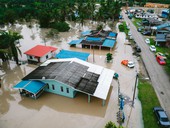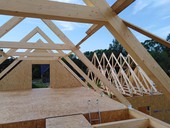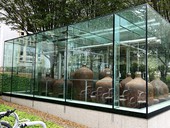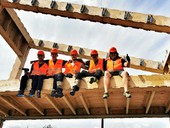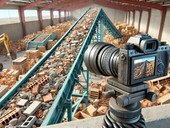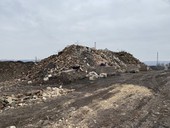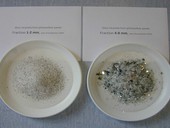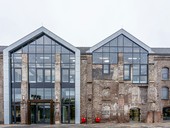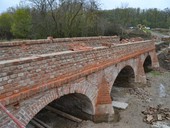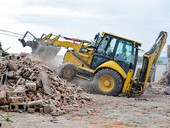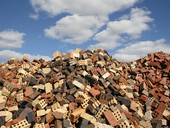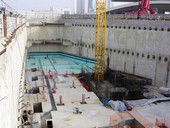The fourth and last part of the series of articles on the problem of masonry buildings situated in floodplains deals with the problem of loading of buildings during the passage of a flood wave. Specifically, the calculation of the load from the vertical buoyancy of water from the flood wave, the load from the dynamic pressure and the load from the dynamic effect of a floating object.
Archiv článků od 10.6.2024 do 24.3.2025
The third part of the series of articles on the problems of masonry buildings located in flood-prone areas deals with the possibilities of rehabilitation of damp masonry partitions after the water from the flood wave has hit. Furthermore, it deals with the issue of underground structures and the flood area, which is also a submerged area. The third part concludes with an introduction to the issue of loading of buildings during the passage of a flood wave.
The second part of the first series of articles on the problems of masonry buildings located in floodplains deals with the peculiarities of historic and listed buildings. It also deals with the treatment of expansion joints, protection against water pressure and the treatment of the internal distribution of technical equipment of buildings. Last but not least, it deals with the issue of rehabilitation of buildings after a flood wave.
This paper begins the first part of a series of articles on the issue of masonry buildings located in floodplains. The first part deals with the general issue of securing existing buildings against the effects of a flood wave, as well as specific possibilities of implementing additional structural modifications to existing buildings. Both in terms of the internal layout and the possibilities of static securing of the supporting structures.
Moisture affects the strength of wood. The strength decreases with increasing humidity. Excessive moisture in wood allows the growth of wood-decay fungi. They attack the building covertly and can cause great damage before they are detected. Wood can be protected against wood-decay fungi by impregnation. Its use in residential buildings is problematic. That is why structural protection is used, i.e. incorporating the wood into the building in such a way that it does not get wet or even soaked and its natural drying out is ensured. During the lifetime of a building, timber can be threatened by high humidity in the structure, condensation, water vapour, leakage or failure of water supply systems and, for example, flooding. It is wise to measure the moisture content of timber in structures and to react in good time to excessive moisture content. Unfortunately, there are not many ways to do this. The method described in this article addresses the monitoring of moisture in timber enclosed in structures.
The paper deals with the design of recycled asphalt mixtures for the bound base layers of pavements. These mixtures are made up of almost 100% reclaimed asphalt mixture adjusted by crushing to a suitable wide fraction. Suitable binder added to the recycled asphalt mixture or heated to a low temperature or is processed by a combination of these technological procedures. The research described in the contribution follows on from the newly created standard ČSN 73 6147 “Recycling of structural layers of roads in the cold”.
This paper presents the results of an experimental investigation into fully transparent bonded joints for load-bearing glass structures. The research specifically focused on the surface properties of glass that affect the load-bearing capacity of the joints, such as surface energy, wettability, and roughness. It also discusses the differences between the tin and air sides of the glass sheets.
The findings are supported by tests conducted at the Faculty of Civil Engineering at CTU between 2021 and 2023. Tensile and dynamic tests of the selected adhesive LOCTITE® EA 9455 as well as shear tests of single-shear glass-to-glass joints, were evaluated, with a focus on the load-bearing capacity of the joints at elevated temperatures.
The paper concludes with a summary of the results and suggests their implications for engineering practice.
The article focuses on the importance of regular inspections and maintenance of smaller steel structures, such as roof walkways, fire escape stairs, or railings, from the perspective of applicable legal regulations and technical standards. It highlights the key requirements of ČSN 73 2604 and other legislative measures that ensure the safety and long-term reliability of these structures. The text also provides practical advice on inspection procedures, inspection frequency, and inspector qualifications. This article serves as a valuable guide for property owners and professionals in occupational health and safety (OHS) and facility management.
The building industry produces more than 30% of the European Union's waste. To reduce this waste, buildings should be designed in line with the principles of the circular economy, so that the products and materials they contain can be removed and reused at the end of the building's life cycle. Therefore, a modular system has been designed, the load-bearing part of which is made up of prefabricated frames composed of plywood. To verify the actual reuse potential of the structure, an experiment was carried out in which a house was assembled and operated for one year. After dismantling the house, the reuse potential of each element was assessed. In this paper, the potential of the main elements of the system for reuse, which overall amounts to 98% by weight of materials used in the system, is described, together with the key barriers to material recovery of the dismantled elements.
The efficient classification of materials in construction debris is crucial for their sorting and further valuable utilization. Current methods, whether relying on force sorters or separators, are reaching their limitations. In many cases, construction and demolition waste materials end up being downcycled or even sent to landfills. Our contribution is divided into two parts. The first part presents facts relating to the production of construction and demolition waste in the EU and justifies the urgency of responsible waste management. It also recaps the development of indirect methods of classification and briefly describes types of suitable sensors for material observation and algorithms for data evaluation. The second part describes our classification solution, developed by the faculties of civil engineering and electrical engineering at CTU in Prague. This method is based on the evaluation of data obtained with ordinary RGB cameras.
Wood-plastic composites are materials that are made from wood and synthetic polymers and have a number of advantages, such as high weather resistance and long life. The aim of this work was to evaluate the influence of plastic filler, waste from cars (painted, unpainted bumpers, fuel tanks) on selected fire-technical properties of wood-plastic composites. From the fire-technical properties, the ignition temperature, mass burning rate and calorific value were evaluated. The results show that the ignition temperature and the average time to initiation of the composites ranged from 260 s to 308 s and the average temperature from 433 °C to 443 °C. In the case of particleboard containing unpainted bumpers and fuel tanks, the time to initiation decreased proportionally with increasing filler concentration. Considering the results of the research, it is necessary to take into account their fire resistance and to increase it, apply protective means incorporated either inside the material or on its surface.
The efficient classification of materials in construction debris is crucial for their sorting and further valuable utilization. Current methods, whether relying on force sorters or separators, are reaching their limitations. In many cases, construction and demolition waste materials end up being downcycled or even sent to landfills. Our contribution is divided into two parts. The first part presents facts relating to the production of construction and demolition waste in the EU and justifies the urgency of responsible waste management. It also recaps the development of indirect methods of classification and briefly describes types of suitable sensors for material observation and algorithms for data evaluation. The second part describes our classification solution, developed by the faculties of civil engineering and electrical engineering at CTU in Prague. This method is based on the evaluation of data obtained with ordinary RGB cameras.
The article presents a project submitted by TAČR in the Environment for Life section 2. The goal of the project is to find the application of recycled glass fractions from photovoltaic panels in the field of construction. The project focuses on three basic silicate building materials, which are able to incorporate glass recyclate shards into their structure during the hydration, firing and melting process. The paper specifies the first results of testing possibilities for use of glass recyclate from photovoltaic panels for concrete masonry units. It compares particular recipes and its physical and mechanical properties with the main focus on the compressive strength. It then compares the values of these recipes with the values of commonly used composite materials for masonry units without recyclates.
The paper discusses the possibilities of diagnosing historical masonry structures by using non-destructive and destructive testing methods. First, the compressive strength of the masonry elements and the compressive strength of the mortar are determined, then the characteristic compressive strength of the masonry is calculated. It is important to assess the bond of the masonry and determine the presence of cracks. Finally, the moisture content and salinity of the masonry shall be determined.
History of Burnt Masonry Elements, Their Identification and Reuse in the Reconstruction of Monuments
The contribution focuses on the current topic of the replacement of historical burnt bricks in heritage-protected buildings. It presents the possibilities of selecting an adequate replacement by recycling historical masonry elements taken from demolished buildings while meeting the requirements placed on current masonry elements with an emphasis on their durability. A resonance method for classifying bricks into quality groups is presented here, along with basic aspects characterizing bricks from different historical periods, which represent another criterion for assessing their suitability for use in historical constructions.
Recycled Plastics in Construction, their Applications and Composites Usable in Construction Practice
Plastic waste in the construction industry can consist of various plastics such as polyethylene, polypropylene, PVC, ABS, polystyrene, polycarbonate. Plastic waste in construction can come from packaging, insulation and other materials. Plastic waste not generated in the construction industry is also recoverable. The best way is to recycle plastic waste into materials that can be used for building materials, fillings, structures, etc. They can also be used in the production of lightweight concrete.
In our practice, we often face the question of building stone provenance on historic buildings. However, methods providing relevant answers to this question are mostly of a destructive character requiring sampling. Therefore, our research has focused on the use of reflectance spectrometry, which is a very promising and effective non-destructive method. This paper discusses the basic principles and possibilities of this method with regard to its application to historic buildings and decorative stone.
The contribution summarizes the fundamental chapters of the transported standard to re-demolition audit and building dismantling as a standard procedure for structure removal. The purpose of the standard will be to prescribe how the pre-demolition audit should proceed, what information it should contain, and how the deconstruction of the building should take place, in order to achieve the maximum possible utilization of the obtained materials. The motivation is primarily the return of quality raw materials to production and the reduction of primary resource extraction, which is one of the goals of sustainable development.
The paper deals with the analysis of mineral construction and demolition waste management in the Czech Republic between 2007 and 2022. The analysis is based on data from the Czech Environmental Information Agency. It has been shown that the production of recycled mineral construction and demolition waste has quadrupled in this period and that the share of recycled mineral construction waste in the market of mineral materials for the construction industry is around 15%.
The main theme of this paper is the usage of the advanced time-dependent elasto-plastic material model for diaphragm walls modeling. First, a theory of time-dependent behaviour is briefly introduced. Next, the Shotcrete material model is described and calibration of materiál model in long term conditions based on laboratory testing is done. Finally, a real boundary value problem of deep excavation supported by diaphragm walls with the strut is solved. Reached values of intemal forces and deformations reached using different modelling methods are compared and discussed.
zpět na aktuální články

